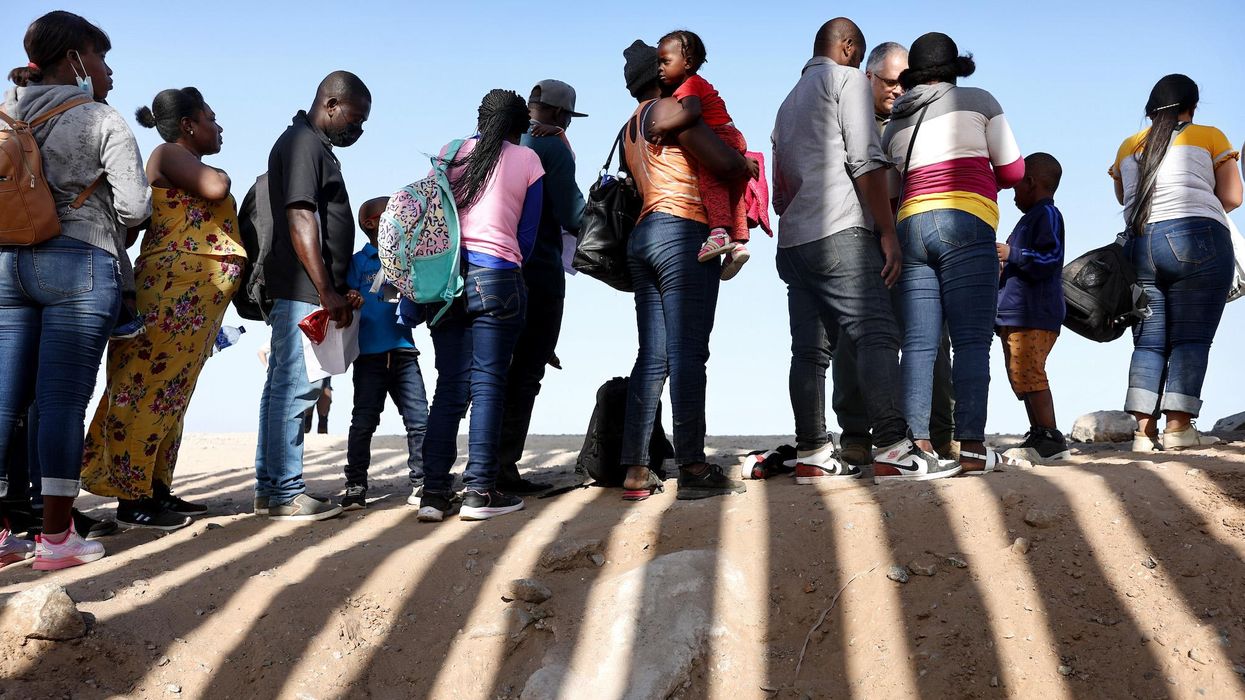(CNN) — Just days before Title 42 was set to end, the Supreme Court is stepping in after an emergency appeal filed by a group of Republican-led states.
Chief Justice John Roberts issued an order Monday temporarily keeping the Trump-era public health restrictions in place and asking the Biden administration to respond to the appeal by 5 p.m. Tuesday.
That means the policy officials have relied on to swiftly expel many migrants from the United States remains in effect — for now. But it's not clear how long that will last.
Roberts is likely to refer to the matter to the full court, and his order signals the court wants to act quickly.
In the meantime, uncertainty looms over Title 42's future — and what happens next at the border.
Here's a look at some of the key questions and answers about Title 42's history, what the court is weighing, what's happening on the ground and what could happen next.
What is Title 42, and when is it set to expire?
In the early days of the coronavirus pandemic, the US Centers for Disease Control and Prevention issued a public health order that officials said aimed to stop the spread of Covid-19. The order allowed authorities to swiftly expel migrants at US land borders. The policy is widely known as Title 42, for the portion of US code that allowed the CDC director to issue it.
Migrants encountered under Title 42 are either expelled to their home countries or into Mexico. Under the policy, authorities have expelled migrants at the US-Mexico border nearly 2.5 million times in less than three years, according to US Customs and Border Protection data.
In a ruling last month, US District Judge Emmet Sullivan ordered the government to end the "arbitrary and capricious" policy. He granted a request for a five-week reprieve, setting a deadline of December 21.
Now after an emergency appeal to the Supreme Court from 19 GOP-led states, that deadline is on hold pending further order from Roberts or the court.
But behind the scenes, the Biden administration is continuing to prepare for the policy's end, a White House official said, given the possibility that any delay will only be brief.
"While this stage of the litigation proceeds, we will continue our preparations to manage the border in a safe, orderly, and humane way when the Title 42 public health order lifts," the Department of Homeland Security said.
How could lifting Title 42 change what's happening at the border?
Officials predict that lifting Title 42 is likely to spur a significant increase in the number of migrants trying to cross into the US.
Last month the Department of Homeland Security was projecting between 9,000 to 14,000 migrants may attempt to cross the US southern border daily when Title 42 ends, more than double the current number of people crossing, according to a source familiar with the projections.
There's no doubt Title 42 has become a policy officials frequently turn to at the border, but it's not the only way migrants' cases are handled. A CNN analysis of 10 months of data earlier this year found that the public health restrictions were applied in about 50 percent of migrant encounters at the southwest border.
If Title 42 is lifted, the way migrants are processed at the border would go back to how it was before 2020. Under that system, migrants are either removed from the country, detained or released into the US while their cases make their way through immigration court.
But officials have also been weighing the possibility of implementing additional policies. Among them: a proposal that would bar migrants from seeking asylum at the US-Mexico border if they could have received refuge in another country they passed through on their journey, mirroring Trump-era asylum limits.
Is there a connection between Title 42 and what's been happening in El Paso?
El Paso Deputy City Manager Mario D'Agostino told reporters last week that about 2,500 migrants were crossing the border there daily.
At this point there isn't any known connection between the rise in crossings there and the looming end of Title 42.
But El Paso officials say they're worried what they're seeing now at the border will only intensify once the policy is lifted.
D'Agostino said already what his city is seeing is different than past surges of migrants across the border
Before, D'Agostino said, increases in migrant populations crossing the border were gradual and over a series of months. This time, he said, it has been rapid and over a few days.
"Our infrastructure cannot keep up," he said.
Why is Title 42 controversial?
The border restrictions were controversial from the moment the Trump administration announced them. Immigrant rights advocates argued officials were using public health as a pretext to keep as many immigrants out of the country as possible. Public health experts also slammed the policy, saying it wasn't justified by the circumstances.
In April, the policy became a political lightning rod and a topic of fierce debate as the Biden administration announced plans to end it. But ultimately, the policy remained in place after a federal judge in Louisiana blocked the administration's plans to roll it back.
Debate resurged after Sullivan's November ruling, and again several weeks later as word spread of the increasing number of migrants crossing in El Paso.
Those who support Title 42 point to border arrests as they argue how essential the pandemic policy has been for blocking illegal immigration. Those who oppose the policy argue official statistics about encounters at the border inflate the severity of the situation, because the data include people crossing the border multiple times. They argue Title 42 has actually caused more border crossings.
The GOP-led states trying to block the lower court from ending the policy argue they'll suffer "irreparable harm" and be forced to spend more money on law enforcement, education and healthcare if Title 42 is lifted. They told the Supreme Court that a "crisis of unprecedented proportions" would unfold at the border if the court failed to issue a stay while justices considered the case.
The DC Circuit US Court of Appeals on Friday had denied the states' request to intervene, ruling that they waited an "inordinate" amount of time before trying to wade into the case. Now the Supreme Court will weigh those states' claims and responses from the government and the American Civil Liberties Union, which is representing migrant families in the case.
Who has been subjected to Title 42?
Earlier this year, Title 42 drew attention when authorities at first were using it to turn away Ukrainians at the border, then largely started granting exceptions that allowed thousands of Ukrainians seeking refuge to cross.
Advocates argued a racist double standard was at play as many migrants from Central America and Haiti continued to be turned back under the policy. Federal officials denied that accusation and said each exemption is granted on a case-by-case basis.
In August, CNN's analysis found that migrants from outside Mexico and the Northern Triangle countries of Guatemala, Honduras and El Salvador were far less likely to be subjected to Title 42.
But for some migrants, that's started to change in recent months. Nearly 6,000 Venezuelan migrants were expelled under Title 42 in October after the Biden administration announced a new policy toward migrants from the South American nation.
Advocates say for many of those who are expelled, the situation is dire.
Since Biden took office, Human Rights First says it's identified more than 13,000 incidents of kidnapping, torture, rape, or other violent attacks on people blocked or expelled to Mexico under Title 42.
Where does the Biden administration stand on Title 42?
The Biden administration has sent mixed messages on Title 42. It has criticized Title 42 and vowed to end its use at the border, but more recently came to rely on the policy.
Many advocates expected President Biden would lift the order as soon as he took office, given his campaign promises to build a more humane immigration system. Instead, his administration extended the policy more than a year into his presidency and defended it for months in court.
In April 2022, the administration announced plans to end the policy, stating that it was no longer necessary given "current public health conditions and an increased availability of tools to fight Covid-19."
After the federal judge in Louisiana blocked that effort, the Justice Department vowed to appeal.
But in October, facing mounting political pressure over a marked increase in migrants crossing the border, the administration announced it was expanding the use of Title 42 to expel Venezuelans into Mexico.
Now once again officials say they're preparing for the policy to end. But they're also appealing the federal judge's recent ruling, arguing that public health restrictions limiting migration are legal.
Whatever happens next is sure to face intense political scrutiny.
Already Sullivan's decision and the increasing number of migrants crossing in El Paso are intensifying debate over the border once again.
The-CNN-Wire
™ & © 2022 Cable News Network, Inc., a Warner Bros. Discovery Company. All rights reserved.

















































